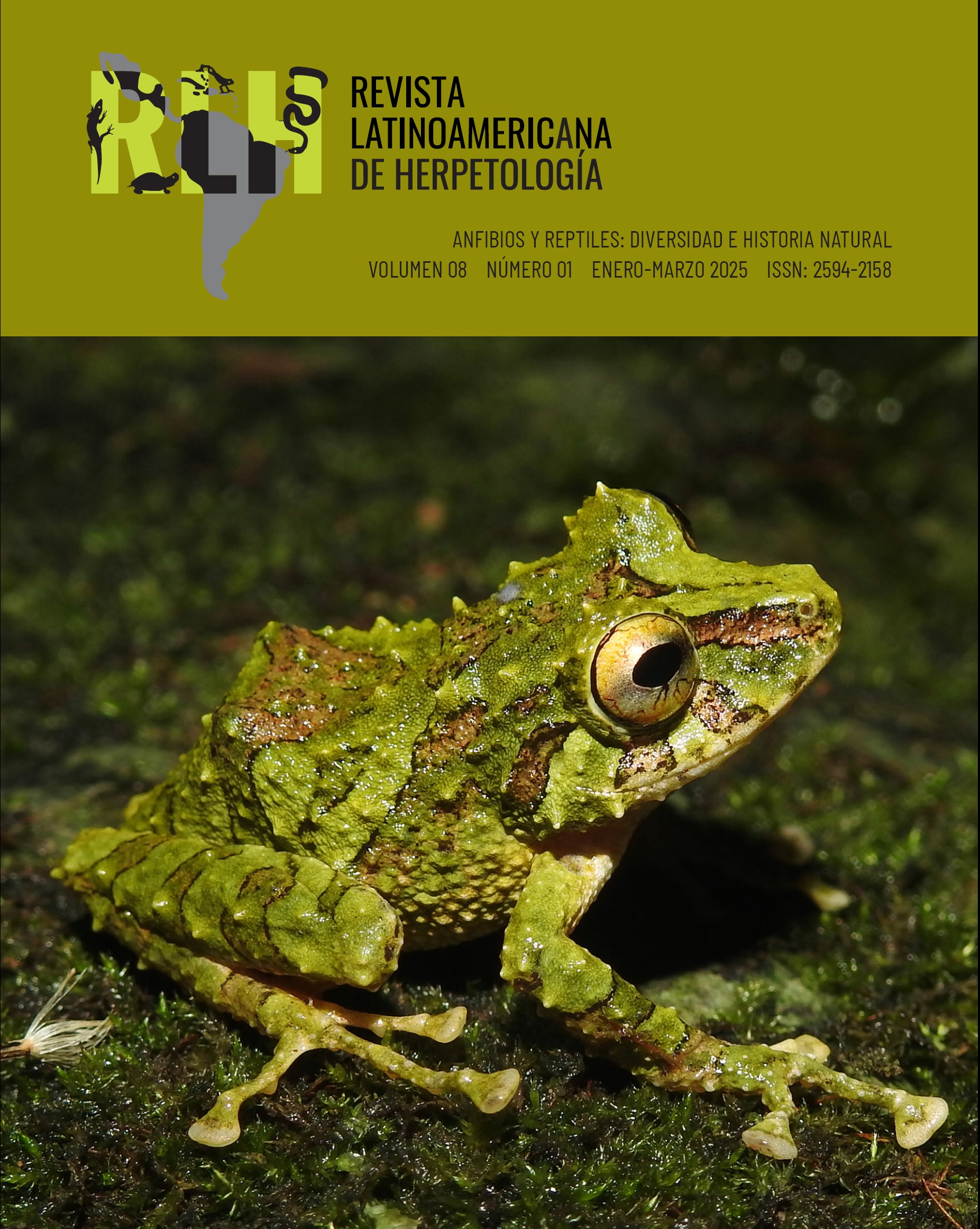COMMUNAL NESTING AND SEXUAL DIMORPHISM IN THE MICROENDEMIC GECKO FROM MEXICO Phyllodactylus delcampoi (GEKKOTA: PHYLLODACTYLIDAE)
DOI:
https://doi.org/10.22201/fc.25942158e.2025.1.1058Keywords:
Guerrero state, natural history, parental care, Phyllodactylus delcampoi, tropical dry forestAbstract
Phyllodactylus consists of nocturnal, oviparous geckos that inhabit rocky areas in tropical and subtropical regions of the Americas, including Mexico. Despite their abundance, knowledge about their natural history is scarce. Here, we documented some reproductive aspects of P. delcampoi, a microendemic gecko from the tropical dry forests of Guerrero, Mexico. We found a communal nest with 18 eggs inside a granite rock crevice. Although communal nesting is known in various gecko species, this is the first documented case in a Mexican lizard species. Communal nesting may be associated with rocky habitats and high individual abundance, as observed in the study species. Furthermore, we found an adult individual that frequently remained close to the surroundings of the community nest, which suggests parental care in P. delcampoi. Additionally, we recorded morphometric measurements to determine sexual dimorphism and found that males are larger and heavier than females.
References
Alfonso, Y.U., P. Charruau, G. Fajardo & A.R. Estrada. 2012. Interspecific communal oviposition and reproduction of three lizard species in Southeastern Cuba. Herpetology Notes 5:73-77.
Argote-Rodríguez, S.I. 2006. Estudio de la reproducción y alimentación de Phyllodcatylus tuberculosus (Sauria: Gekkonidae) en el Itsmo de Tehuantepec, Oaxaca. Tesis de Licenciatura. Facultad de Estudios Superiores Iztacala, Universidad Nacional Autónoma de México. Los Reyes Iztacala, Estado de México, México.
Colli, G.R., D.O. Mesquita, P.V. Rodrigues & K. Kitayama. 2003. Ecology of the gecko Gymnodactylus geckoides amarali in a Neotropical savanna. Journal of Herpetology 37:694-706.
Christian, A. & T. Garland Jr. 1996. Scaling of limb proportions in monitor lizards (Squamata: Varanidae). Journal of Herpetology 30:219-230.
Dixon, J.R. 1964. The systematics and distribution of lizards of the genus Phyllodactylus in North and Central America. New Mexico State University. Scientific Bulletin 64:1-139.
Domingos, F.M., Í.C. Arantes, R.J. Bosque & M.G. Santos. 2017. Nesting in the lizard Phyllopezus pollicaris (Squamata: Phyllodactylidae) and a phylogenetic perspective on communal nesting in the family. Phyllomedusa: Journal of Herpetology 16:255-267.
Doody, J.S., S. Freedberg & J.S. Keogh. 2009. Communal egg-laying in reptiles and amphibians: evolutionary patterns and hypotheses. The Quarterly Review of Biology 84:229-252.
Doughty, P. 1997. The effects of "fixed" clutch sizes on lizard life-histories: reproduction in the Australian velvet gecko, Oedura lesueurii. Journal of Herpetology 31:266-272.
García-Bastida, M., D. Lazcano, L.D. McBrayer & R. Mercado-Hernández. 2013. Sexual dimorphism in the alligator lizard Gerrhonotus infernalis (Sauria: Anguidae): implications for sexual selection. The Southwestern Naturalist 58:202-208.
Goldberg, S.R. 2007. Notes on reproduction of Peters’ Leaf-toed Gecko, Phyllodactylus reissii (Squamata, Gekkonidae), from Peru. Phyllomedusa: Journal of Herpetology 6:147-150.
Graves, B.M. & D. Duvall. 1995. Aggregation of squamate reptiles associated with gestation, oviposition, and parturition. Herpetological Monographs 9:102-119.
Greer, A.E. 1967. The ecology and behavior of two sympatric Lygodactylus geckos. Breviora 268:1-19.
Husak, J.F., S.F. Fox, M.B. Lovern & R.A.V.D. Bussche. 2006. Faster lizards sire more offspring: sexual selection on whole animal performance. Evolution 60:2122-2130.
Mateo, J.A. & M. Cuadrado. 2012. Communal nesting and parental care in Oudri's fan-footed gecko (Ptyodactylus oudrii): field and experimental evidence of an adaptive behavior. Journal of Herpetology 46:209-212.
Montgomery, C.E., E.J.G. Rodriquez, H.L. Ross & K.R. Lips. 2011. Communal nesting in the anoline lizard Norops lionotus (Polychrotidae) in central Panama. The Southwestern Naturalist 56:83-88.
Muñoz-Nolasco, F.J., D.M. Arenas-Moreno, R. Santos-Bibiano, A. Bautista-del Moral, F.J. Gandarilla-Aizpuro, D.A. Brindis-Badillo & F.R. Méndez-de la Cruz. 2019. Evaporative water loss of some habitat-restricted Mexican lizard species. Herpetological Conservation and Biology 14:51-66.
Okada, S., M. Izawa & H. Ota. 2002 Growth and reproduction of Gekko hokouensis (Reptilia: Squamata) on Okinawajima island of the Ryukyu archipelago, Japan. Journal of Herpetology 36:473-479.
Palacios-Aguilar, R., R. Santos-Bibiano & O. Flores-Villela. 2018. A new species of Lepidophyma (Squamata: Xantusiidae) from the Pacific lowlands of Guerrero, Mexico. Journal of Herpetology 52:327-331.
Pike, D.A., J.K. Webb & R.M. Andrews. 2011. Social and thermal cues influence nest‐site selection in a nocturnal gecko, Oedura lesueurii. Ethology 117:796-801.
Ramírez-Bautista, A. & N.P. Pavon. 2009. Sexual dimorphism and reproductive cycle in the arboreal spiny lizard Sceloporus formosus Wiegmann (Squamata: Phrynosomatidae) from central Oaxaca, Mexico. Revista Chilena de Historia Natural 82:553-563.
Ramírez-Reyes, T. & O. Flores-Villela. 2018. Taxonomic changes and description of two new species for the Phyllodactylus lanei complex (Gekkota: Phyllodactylidae) in Mexico. Zootaxa 4407:151-190.
Ramírez-Sandoval, E., A. Ramírez-Bautista & L.J. Vitt. 2006. Reproduction in the lizard Phyllodactylus lanei (Squamata: Gekkonidae) from the Pacific Coast of Mexico. Copeia 1:1-9.
Secretaría de Medio Ambiente y Recursos Naturales (SEMARNAT). 2010. Norma Oficial Mexicana NOM-059-SEMARNAT 2010, Protección ambiental-Especies nativas de México de flora y fauna silvestres-Categorías de riesgo y especificaciones para su inclusión, exclusión o cambio-Lista de especies en riesgo. Diario Oficial de la Federación. 30 de diciembre de 2010. Segunda Sección. México.
Vitt, L.J. 1982. Sexual dimorphism and reproduction in the microteiid lizard, Gymnophthalmus multiscutatus. Journal of Herpetology 16:325-329.
Vitt, L.J. 1986. Reproductive tactics of sympatric gekkonid lizards with a comment on the evolution and ecological consequences of invariant clutch size. Copeia 1986:773-786.
Zar, J.H. 1999. Biostatistical analysis, 4th edition. Pearson Prentice Hall, Upper Saddle River, New Jersey, USA.
Zhang, Y.P., W.G. Du & L.J. Zhu. 2009. Differences in body size and female reproductive traits between two sympatric geckos, Gekko japonicus and Gekko hokouensis. Folia Zoologica 58:113.
Downloads
Published
How to Cite
Issue
Section
License
Copyright (c) 2025 Revista Latinoamericana de Herpetología

This work is licensed under a Creative Commons Attribution-NonCommercial-ShareAlike 4.0 International License.







